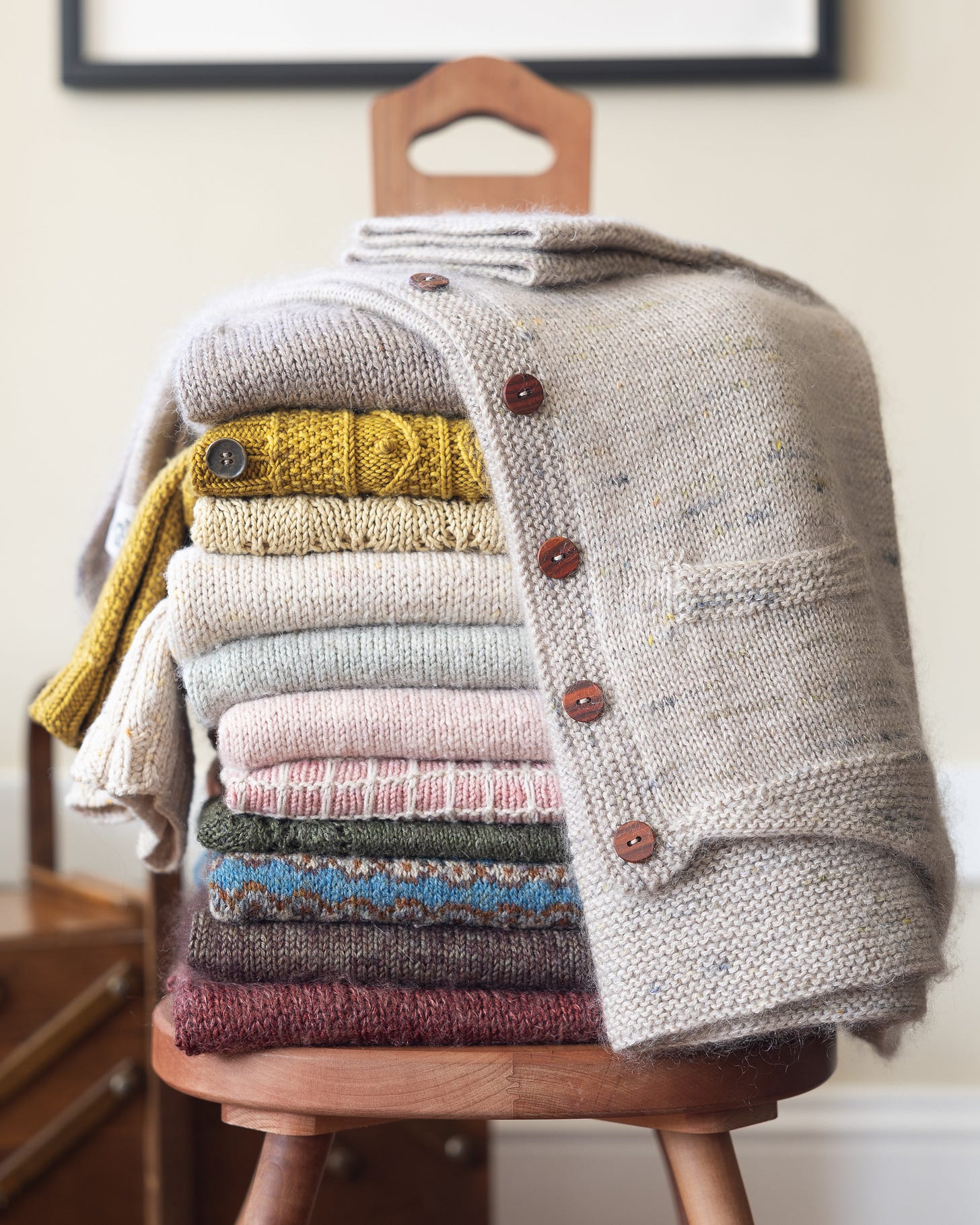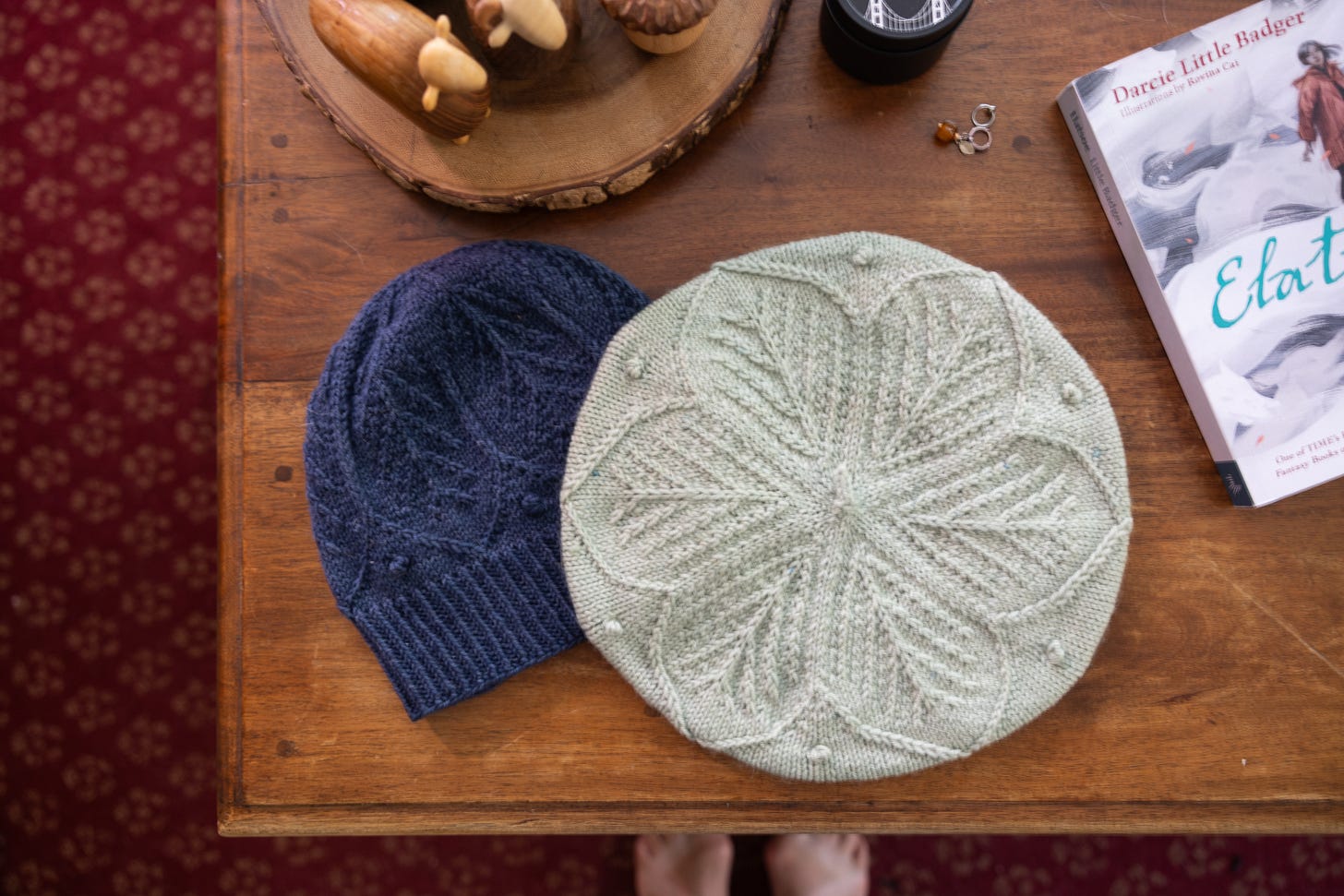Living with less, somehow ending up with more
How to infuse a bit of slow, small, and sweet into your ever-growing knitwear collection

For the past few years, the majority of my knitting has been focused on sweaters. I’ve made between 6 and 8 sweaters each year.
I’ve been deeply interested in trying different yarns and fibers to learn what will give a sweater a long life, in learning why I prefer a certain construction over another, and in learning how different angles and shapes feel on my body.
Of the many sweaters I’ve made, not all of them have hit the mark.
You would think, after knitting so many sweaters, by now, every time I make a sweater it’s a bullseye for style and fit.
But knitting is here to tell me something different. It’s here to tell me there’s always something new to learn.
I currently have about 40 sweaters in my closet, and I wear about 30 of them regularly. (I’m including my “special occasion” sweaters like the deep red one, pictured above, which I often wear just for winter holiday occasions, or summer sweaters like the pale yellow lace top that might get worn just a few times each summer, but which I have reliably reached for at least once, season after season.)
Slow fashion brand, Pareto, found that US women only wear about 20 percent of the clothing they own, so the fact that I regularly wear 75 percent of my knitwear makes me happy. It feels really good to hone my wardrobe to the pieces I love to wear, which fit my body, and which suit my style. It feels small-ish and hopeful and fresh.
But there are still ~10 beautiful, handmade sweaters I simply do not wear.
Some of them don’t fit my body right now. A few turned out to be not as suitable as I had hoped for our mild winters here in San Francisco. Some of them don’t suit my evolving style.
Clothing is so personal and it should also be joyful. It’s how we present ourselves to the world. It’s an outward view of how we feel inside.
Think of the excitement of binding off a sweater you’ve been working on for, maybe, months. I always feel a sense of accomplishment and pleasure when I weave in those final ends and soak and block my new garment. I love to marvel at what my hands can do.
And I love to wear that new item of clothing. I love its new clothing feeling on my body. I love the zing of excitement of a new outfit, a new color, a new garment.
We all know that too many clothes are killing our planet. Most people buy four times as many new items of clothing each year as they did just two decades ago. Fast fashion contributes a full 10 percent of greenhouse gas emissions (all statistics are from this source). And yet, advertising (and capitalism and just everything out there) makes us forget that we don’t need more clothes. It weaves a spell and tells us to keep pursuing the right clothes. The right purchase. Over and over and over again
I’ve managed to curb my own desires for new clothing by making things.
I still enjoy the unabashed feeling of a new garment and I know that by making it myself—and quite literally slowing down the process—I am doing my part to consume less. I suspect you feel the same.
In spite of all this—a thoughtful making practice, deep skills in sweater knitting, a knowledge of yarn and fiber—I still have unworn sweaters. Maybe you do, too?
I’m coming to realize: it’s okay to make something and realize, sometime down the line, this item is no longer one I want in my day-to-day wardrobe. It’s okay to hang onto it for sentimental reasons. And it’s okay to re-home it.
What I haven’t been able to do, until now, was have a really great way of finding a new home for knitwear I wanted to re-home.
And so, I’d like to embark with you on my very first community project.
Let’s clean out our knitwear collections!
Do you, like me, have handknit hats, sweaters, shawls, and other things you don’t wear?
Maybe it’s something that doesn’t fit your current body. Maybe it was a project you really wanted to knit, but discovered you didn’t actually want to wear. Maybe it’s a sweater that’s too warm for your climate. Or, like me, you really like knitting hats but don’t find much occasion to wear them.
Going through your knitwear can be as big or as small of a job as you have time and energy for. It can be a comprehensive job of pulling out all your knitwear, trying it on, and assessing the fit and style. Or it can be as simple as opening a drawer and finding one or two items you know you don’t wear.
For me, I often stall out on even attempting a project like this because I either don’t know what to do with the unworn items, or don’t like any of the options. For example:
You can unravel a project, wash the yarn, and re-use it.
You can donate the item to a thrift shop. As an endorsement of why it’s great to donate to thrift shops, I want to lift up this comment from @alannajaneartisan in my Instagram community:
“I live exclusively on disability (i.e., low income). I knit and sew. But, I find that so many people are averse to donating high-quality clothing—and I think it’s very sad. Why do you think that someone you know will love and care for something you made better than a stranger in need?… Honestly, the quality in thrift has plummeted in the last decade, thanks to fast fashion, and we low-income folks want to also find treasures that will last decades.
You can re-home it.
You can sell it or raffle it.
All of these are viable and worthy options. And they each require a level of work, knowledge, and capacity—and have a degree of uncertainty involved.
While there is no single perfect solution, I’d like to add one more option to what you and I can do with our unworn beautiful handmade items.
Please meet: the Swap Shop
There is a wonderful volunteer-run Instagram account that sells and rehomes slow fashion brands. I am starting something similar (but more economically inclusive) for hand-knit and hand-crocheted garments and accessories, here on the newsletter.
Here’s the idea:
It will be a perk for paid subscribers of this newsletter, with scholarships available.
Items will not be for sale, but gifted. Recipients will pay for shipping.
Paid subscribers will be able to list 2 items gratis, and you’ll be able to list more for a few dollars each.
You’ll be able to peruse what’s on offer via a shoppable thread or a section of my website.
You’ll be able to purchase shipping materials and shipping labels from me if you need that extra service. (I’m all set up for easy shipping as part of my business, and I know that not everyone has the ability or capacity to figure out these things.)
Think about how great it will feel to clean out a few items of knitwear from your closet and to know that those items are going to someone who will wear and appreciate them and give them a good, long life.
We don’t often need to do the Big Thing to feel good. Small things can be just as meaningful. Like sending a handknit sweater to someone who wants it, and reclaiming that small bit of space in our closet.
PS: I am so excited for the Swap Shop! I love the idea of doing things, like this, with this newsletter (and my business platform in general) that are small, tangible ways to connect us and make our lives just a tiny bit better.






When I was selling yarn a lot (destashing) I just put shipping included, and then added a little to the price I was charging to cover part of the shipping expense.
For future iterations, maybe a way to gift shipping of our item, if we’re in a position to do so, or to gift into a shipping pool? My heart is so happy for this swap. 💗💗💗